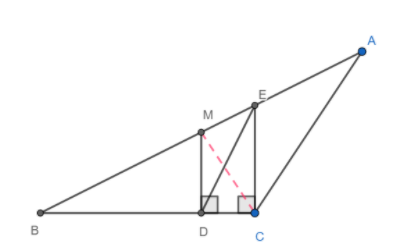
In the obtuse triangle ABC, AM = MB , $MD\bot BC,EC\bot BC$ and the area of the triangle ABC is 24. The area of the triangle BED is
[a] 9
[b] 12
[c] 15
[d] 18
Answer
574.5k+ views
Hint: Join CM. Use the fact that the median of a triangle divides the triangle into two triangles of equal area. Hence prove that $ar\left( \Delta BMC \right)=12$ Use the fact that the areas of triangles on the same base and between the same parallels are equal and hence find the area of the triangle BDE.
Complete step-by-step answer:

Given: ABC is an obtuse-angled triangle, with obtuse angle at C. M is the midpoint of AB and MD is perpendicular to BC. The perpendicular to BC at point C intersects AB at E. Area of the triangle ABC is 24.
To determine: Area of the triangle BDE.
Construction: Join CM.
In triangle ABC, we have CM as the median of the triangle (as M is the midpoint of AB).
We know that in a triangle the median of the triangle divides the triangle into two triangles of equal area. Hence, we have
$ar\left( \Delta AMC \right)=ar\left( \Delta BMC \right)=\dfrac{1}{2}ar\left( \Delta ABC \right)$
Since the area of the triangle ABC is 24, we have
$ar\left( \Delta BMC \right)=\dfrac{1}{2}\times 24=12$
From the figure, we have
$ar\left( \Delta BMC \right)=ar\left( \Delta BDM \right)+ar\left( \Delta CDM \right)$
Hence, we have
$ar\left( \Delta BDM \right)+ar\left( \Delta CDM \right)=12\text{ }\left( i \right)$
Since MD and EC are perpendicular on the same line BC, MD||BC.
Triangles EDM and CDM are on the same base MD and between the same parallels, MD and EC
We know that the areas of triangles on the same base and between the same parallels is equal.
Hence, we have
$ar\left( \Delta EDM \right)=ar\left( \Delta CDM \right)$
Substituting the value of $ar\left( \Delta CDM \right)$ in equation (i), we get
$ar\left( \Delta BDM \right)+ar\left( \Delta EDM \right)=12$
From the figure, we have $ar\left( \Delta BDM \right)+ar\left( \Delta EDM \right)=ar\left( \Delta BDE \right)$
Hence, we have $ar\left( \Delta BDE \right)=12$
Hence option [b] is correct.
Note: [1] In these types students often get confused which formulae to use and how to find the value. It can be noted that the following properties are helpful in finding areas.
[a] Median of a triangle divides the triangle into two triangles of equal area
[b] Areas of two congruent triangles are equal
[c] The ratio of areas of two similar triangles is equal to the square of the ratio of their corresponding sides
[d] Areas of triangles/parallelograms on the same base and between the same parallels are equal.
Complete step-by-step answer:

Given: ABC is an obtuse-angled triangle, with obtuse angle at C. M is the midpoint of AB and MD is perpendicular to BC. The perpendicular to BC at point C intersects AB at E. Area of the triangle ABC is 24.
To determine: Area of the triangle BDE.
Construction: Join CM.
In triangle ABC, we have CM as the median of the triangle (as M is the midpoint of AB).
We know that in a triangle the median of the triangle divides the triangle into two triangles of equal area. Hence, we have
$ar\left( \Delta AMC \right)=ar\left( \Delta BMC \right)=\dfrac{1}{2}ar\left( \Delta ABC \right)$
Since the area of the triangle ABC is 24, we have
$ar\left( \Delta BMC \right)=\dfrac{1}{2}\times 24=12$
From the figure, we have
$ar\left( \Delta BMC \right)=ar\left( \Delta BDM \right)+ar\left( \Delta CDM \right)$
Hence, we have
$ar\left( \Delta BDM \right)+ar\left( \Delta CDM \right)=12\text{ }\left( i \right)$
Since MD and EC are perpendicular on the same line BC, MD||BC.
Triangles EDM and CDM are on the same base MD and between the same parallels, MD and EC
We know that the areas of triangles on the same base and between the same parallels is equal.
Hence, we have
$ar\left( \Delta EDM \right)=ar\left( \Delta CDM \right)$
Substituting the value of $ar\left( \Delta CDM \right)$ in equation (i), we get
$ar\left( \Delta BDM \right)+ar\left( \Delta EDM \right)=12$
From the figure, we have $ar\left( \Delta BDM \right)+ar\left( \Delta EDM \right)=ar\left( \Delta BDE \right)$
Hence, we have $ar\left( \Delta BDE \right)=12$
Hence option [b] is correct.
Note: [1] In these types students often get confused which formulae to use and how to find the value. It can be noted that the following properties are helpful in finding areas.
[a] Median of a triangle divides the triangle into two triangles of equal area
[b] Areas of two congruent triangles are equal
[c] The ratio of areas of two similar triangles is equal to the square of the ratio of their corresponding sides
[d] Areas of triangles/parallelograms on the same base and between the same parallels are equal.
Recently Updated Pages
Two men on either side of the cliff 90m height observe class 10 maths CBSE

What happens to glucose which enters nephron along class 10 biology CBSE

Cutting of the Chinese melon means A The business and class 10 social science CBSE

Write a dialogue with at least ten utterances between class 10 english CBSE

Show an aquatic food chain using the following organisms class 10 biology CBSE

A circle is inscribed in an equilateral triangle and class 10 maths CBSE

Trending doubts
Why is there a time difference of about 5 hours between class 10 social science CBSE

Write a letter to the principal requesting him to grant class 10 english CBSE

What is the median of the first 10 natural numbers class 10 maths CBSE

The Equation xxx + 2 is Satisfied when x is Equal to Class 10 Maths

Which of the following does not have a fundamental class 10 physics CBSE

State and prove converse of BPT Basic Proportionality class 10 maths CBSE




